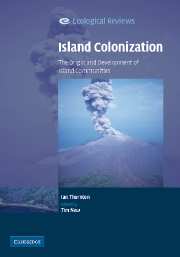PART IV - Assembly of biotas on new islands
Published online by Cambridge University Press: 12 January 2010
Summary
Starting points
One problem with studies of recovery after presumed extirpation of a biota is the doubt that almost always exists about the completeness of the eradication of life. For example, in the case of Volcano Island (Taal Volcano) it is known that a small remnant of vegetation survived the eruption, and doubts concerning the complete eradication of both animals and plants have been expressed concerning the eruptions of Thera (Schmalfuss and Schawaller 1984) and Krakatau (e.g. Backer 1929, but see Docters van Leeuwen 1936 and Dammerman 1948). In his children's fantasy The Water Babies, Charles Kingsley (1915: 61, 62) pointed out that ‘no one has a right to say that no water babies exist, till they have seen no water babies existing; which is quite a different thing, mind, from not seeing water babies …’. Absence of evidence is not necessarily evidence of absence, and this is certainly true for seed plants, which may survive, unrecorded, in seed banks in the soil (Whittaker et al. 1995), as well as for animal groups whose mobility and cryptic or nocturnal habits may mean that they escape detection even in specialist surveys.
On newly created land there can be no question of ‘not seeing water babies’. As far as land organisms are concerned the substrate is new, clearly virgin, abiotic, and, if studied soon enough (as on Surtsey), the beginnings of a primary xerosere (terrestrial succession) can be observed.
Marine cays are such newly created islands.
- Type
- Chapter
- Information
- Island ColonizationThe Origin and Development of Island Communities, pp. 133 - 136Publisher: Cambridge University PressPrint publication year: 2007



